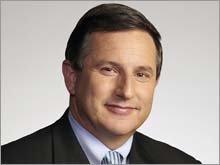 |
| Mark Hurd unveiled his strategy for improvement at HP during a day-long analyst meeting in New York. |
|
|
|
NEW YORK (CNNMoney.com) -
The cost cutting at Hewlett-Packard is having a positive effect on profits, but revenue growth is proving a little harder to come by, the chief executive of the Number Two computer told analysts Tuesday.
Nevertheless the company, by continuing to buckle down on operating issues and further developing its digital print operations, hopes to increase revenue by up to 6 percent in the coming fiscal year.
"We've got a lot of stuff to go work on. You may not always like what we say ... but we will work exceedingly hard to deliver on commitments we set," said Mark Hurd in his first face-to-face talk with Wall Street analysts since taking over the CEO post from Carly Fiorina.
New guidance
Chief Financial Officer Bob Wayman said HP expects revenues of $89.5 billion to $91 billion for its 2006 fiscal year, a range allowing for a lower result than $90.85 billion analysts had been expecting. However, Wayman said that the company expects earnings of $1.88 to $1.95 a share. Analysts had been expecting $1.82 a share.
For 2007, the company expects revenue growth of 4 to 6 percent. Analysts expect overall HP revenue of $95.25 billion for 2007, with earnings, excluding items, of $2.09 per share. Wayman said that the "operating model" for fiscal 2007 is for year-over-year revenue growth of 4 percent to 6 percent and an operating margin of 7.5 percent to 8.9 percent. If HP hits the midpoint of those ranges, earnings per share will be $2.12, the CFO said.
HP's stock (Research) sank on the news.
The projections are confirmation of Hurd's emphasis on cutting costs. But up until now investors and analysts have heard little about how he plans to grow the company.
At HP's (down $0.82 to $29.15, Research) day-long analyst meeting in New York -- its first since Hurd took the helm on April 1 -- Hurd for the first time publicly outlined his strategy for growing the computing giant and making it more competitive against rivals such as Dell (up $0.55 to $32.93, Research) and IBM/Lenovo (down $2.18 to $83.78, Research).
The plan included few surprises: continuing to cut costs, improving gross margin and leveraging the company's existing technology portfolio.
Hurd also said that when he arrived at HP, he found more advanced technology than he was expecting, but "mixed" employee morale and an inability to execute well on its plans.
"I found a company deep in data, deep in information; they had done a lot of work, it just hadn't been executed."
Hurd handed out bigger employee bonuses than the company has issued in some time, which analysts viewed as a positive move to motivate employees.
The theme of "execution" has been persistent since Hurd came to HP, and the focus on doing a better job of implementing business plans that were already in place before his arrival has been a central focus of his tenure thus far.
Hurd acknowledged the problems he faced when he took over, saying the company was "undervalued, with a very challenged multiple."
"The company has been inconsistent; the stock has been volatile and to some degree disappointing because of that inefficiency," he said.
Cleaning house
After taking the reins, Hurd quickly began cleaning house and slashing costs, cutting 15,300 jobs. The company produced two consecutive better than expected quarters and Wall Street reacted enthusiastically. The stock has surged, from lows near $20 in the beginning of October to its current price near $30.
And cost cutting remains a big priority for Hurd, citing it as an important step toward improving gross margin, a key measure of profitability.
"We will execute on our cost structure," he said. "That is one of the ways that we have an opportunity to fuel our growth."
The company can expect to face continued pressure to improve operating margins. Wayman also said that capital expenditure, which has been steady, will ramp up in 2006.
"We are going to go through a major transformation of our IT capabilities; as a result we will have heavy capital spending of $2.2 billion of net capital expenditure. This will have a major impact on cash flow."
Hurd outlined objectives for the company's Printing and Imaging Group, a $25 billion business, saying the company will focus on "printing, not printers." The operating margin for the traditionally strong unit should be between 13 and 15 percent, executives said.
Vyomesh Joshi, executive vice president of HP's $25 billion imaging and printing group, said that HP sees three growth opportunities in the segment: more every day office printing being done in color; the growth of digital photos; and the rise of companies bringing the production of office documents in-house.
Joshi focused on the growth in the number of pages printed and outlined some steps HP is taking to make sure more of those pages are printed on HP products. These include recent announced acquisitions such as photo storage web site Snapfish and Picaxo, a similar site in Europe.
The company yesterday launched Halo, a slick new video conferencing solution that, while technologically superior to traditional video conferencing products, comes with a hefty $550,000 price tag. At the New York launch of the product, which acts as a "virtual conference room," HP enlisted the help of Jeffrey Katzenberg, chief executive of DreamWorks (down $0.35 to $25.11, Research), as well as Advanced Micro Devices (down $0.12 to $26.87, Research) chief executive Hector Ruiz, to pitch the new product.
Reuters contributed to this report.
----------------------
Which computer maker is No. 1 with online shoppers? Click here to find out.

|